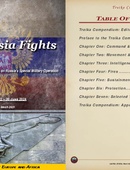
The Center for Army Lessons Learned leads the Army Lessons Learned Program and delivers timely and relevant information to resolve gaps, enhance readiness, and inform modernization.

Downloads: 259
Hits: 259
This publication reveals how U.S. Army South (ARSOUTH) planned for PANAMAX 24 (PMX24), how they transitioned to a multinational force headquarters,... read more
This publication reveals how U.S. Army South (ARSOUTH) planned for PANAMAX 24 (PMX24), how they transitioned to a multinational force headquarters, Multinational Force South (MNFS), and presents both the successes and challenges while conducting OPERATION FUTURO NOBLE to secure the Panama Canal. The chapters contain input from ARSOUTH Directorates and Special Staff, with lessons and best practices from across the warfighting functions (WfFs). In addition, towards the end of the publication, there are multiple U.S. and partner nation (PN) key leader interviews. Because of the experience level of those interviewed, responses to questions are both forthright and precise on issues. What is shared not only benefits this command but has applicability for other units preparing for a similar mission set.
less

Downloads: 128
Hits: 128
This article advocates for the widespread adoption of Tranexamic Acid (TXA) across all levels of military medical care to significantly reduce trauma... read more
This article advocates for the widespread adoption of Tranexamic Acid (TXA) across all levels of military medical care to significantly reduce trauma related mortality. Evidence from civilian trials, military studies, the recent experience in the Russo-Ukraine War, and the subsequent critical study demonstrates TXA's effectiveness in controlling hemorrhage and improving survival rates -- with Ukraine reporting a 33% reduction of deaths.
less

Downloads: 289
Hits: 289
This compendium of observations covers the first 2-plus years of the Russian “Special Military Operation” (SMO) in Ukraine and is intended to help... read more
This compendium of observations covers the first 2-plus years of the Russian “Special Military Operation” (SMO) in Ukraine and is intended to help American military leaders better understand our potential enemy—the Russian military. The compendium summarizes and categorizes Russian military performance, drawing from over 200 observation reports over more than 2 years, from 24 February 2022 through 1 May 2024. The document curates and consolidates the most significant observations and vignettes and assembled them according to the U.S. Army warfighting functions - Command and Control, Movement and Maneuver, Intelligence, Fires, Sustainment, and Protection.
less

Downloads: 1319
Hits: 1319
The Home Station Training Handbook offers a comprehensive overview of Army training management, covering the key principles and best practices that underpin... read more
The Home Station Training Handbook offers a comprehensive overview of Army training management, covering the key principles and best practices that underpin successful training. It provides guidance on planning, preparing, and executing training, as well as assessing and evaluating its effectiveness. The handbook also addresses the importance of safety, risk management, and resource allocation, and offers practical advice on how to overcome common challenges and obstacles.
less

Downloads: 1285
Hits: 1285
This report details the experiences and lessons learned by Task Force Blackhawk during Exercise Arctic Forge 2025, a challenging training event focused on... read more
This report details the experiences and lessons learned by Task Force Blackhawk during Exercise Arctic Forge 2025, a challenging training event focused on operations in austere, arctic environments alongside NATO allies. While the Task Force ultimately achieved mission success, it faced significant hurdles related to preparation, communications, and mobility.
less

Downloads: 1251
Hits: 1251
While previous techcraft articles gathered insight from direct leadership feedback, this deeper study used a more rigid framework to analyze units that have... read more
While previous techcraft articles gathered insight from direct leadership feedback, this deeper study used a more rigid framework to analyze units that have been successful in innovation and integration, to generate Doctrine, Organization, Training, Materiel, Leadership and Education, Personnel, Facilities, and Policy (DOTMLPF-P) recommendations for the Army.
This article is the culmination of Army Futures Command and The Center for Army Lessons Learned collaborative effort to collect Techcraft lessons and best practices concerning the underlying Soldier attributes, leader behaviors, and unit culture which contributes to successful integration of advanced military technologies in our Army today.
less







